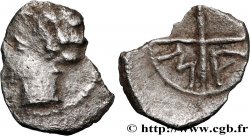E-auction 39-14916 - bga_198282 - SALUVII Obole stylisée, MA, imitation
You must signin and be an approved bidder to bid, LOGIN TO BID. Accounts are subject to approval and the approval process takes place within 48 hours. Do not wait until the day a sale closes to register. Clicking on « bid » constitutes acceptance of the terms of use of cgb.fr private e-auctions.
Bids must be placed in whole Euro amounts only. The sale will start closing at the time stated on the item description; any bids received at the site after the closing time will not be executed. Transmission times may vary and bids could be rejected if you wait until the last second. For further information ckeck the E-auctions F.A.Q.
NO BUYER'S FEE.
NO BUYER'S FEE.
| Estimate : | 20 € |
| Price : | 9 € |
| Maximum bid : | 16 € |
| End of the sale : | 13 January 2014 15:07:30 |
| bidders : | 4 bidders |
Type : Obole stylisée, MA, imitation
Date: c. 150-50 AC.
Metal : silver
Diameter : 10,5 mm
Weight : 0,4 g.
Rarity : R1
Coments on the condition:
Flan relativement large avec un droit fruste mais un agréable revers complet. Patine grise, surtout au revers
Catalogue references :
Obverse
Obverse legend : ANÉPIGRAPHE.
Obverse description : Lisse.
Reverse
Reverse legend : M-A DANS LES 3E ET 4E CANTONS.
Reverse description : Roue à quatre rayons avec moyeu central.
Commentary
Ces monnaies seraient des imitations des oboles de Marseille, largement stylisées et dégénérées, émises par les peuples de l'arrière pays marseillais.
Le droit de cet exemplaire est très proche du bga_198283.
These coins are said to be imitations of the Marseille obols, largely stylized and degenerate, issued by the peoples of the Marseille hinterland. The obverse of this example is very close to bga_198283
Le droit de cet exemplaire est très proche du bga_198283.
These coins are said to be imitations of the Marseille obols, largely stylized and degenerate, issued by the peoples of the Marseille hinterland. The obverse of this example is very close to bga_198283








 Report a mistake
Report a mistake Print the page
Print the page Share my selection
Share my selection Ask a question
Ask a question Consign / sell
Consign / sell
 Full data
Full data











